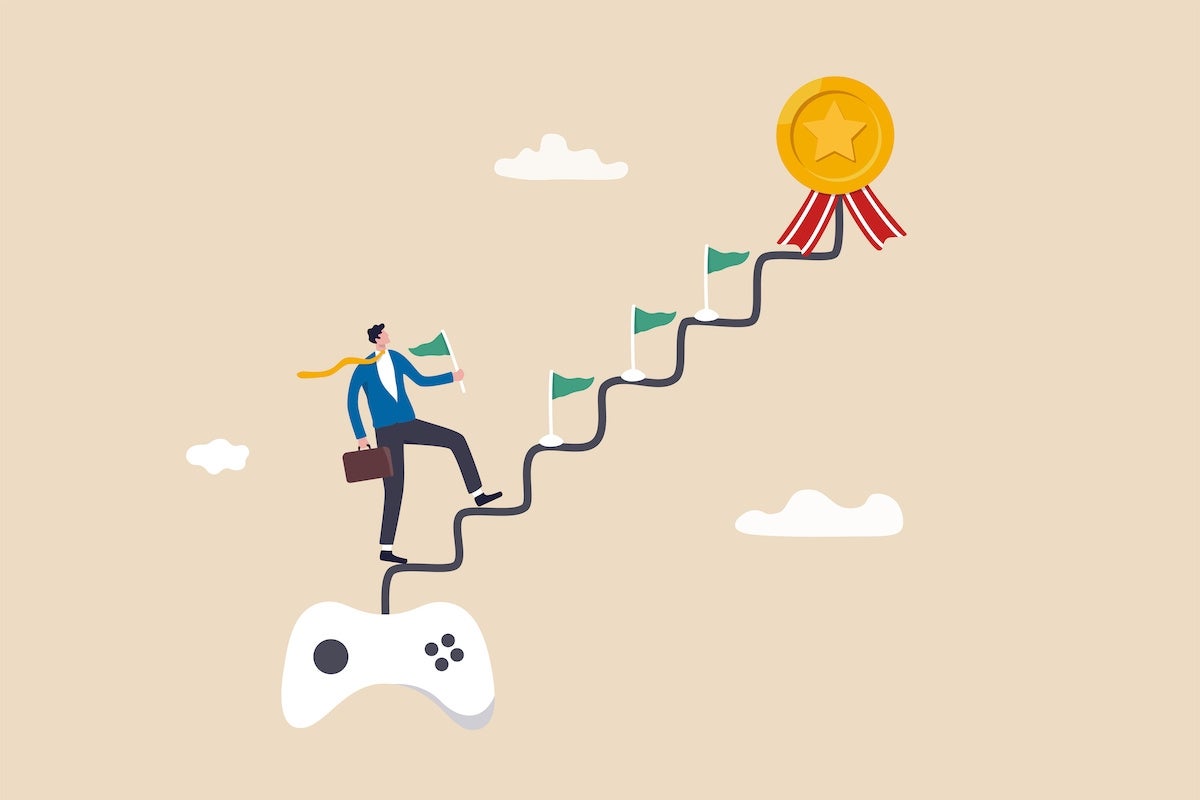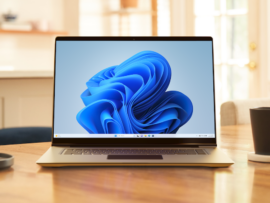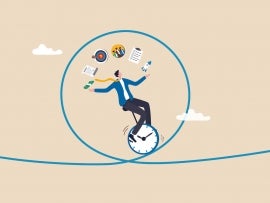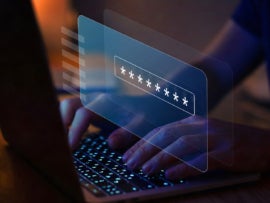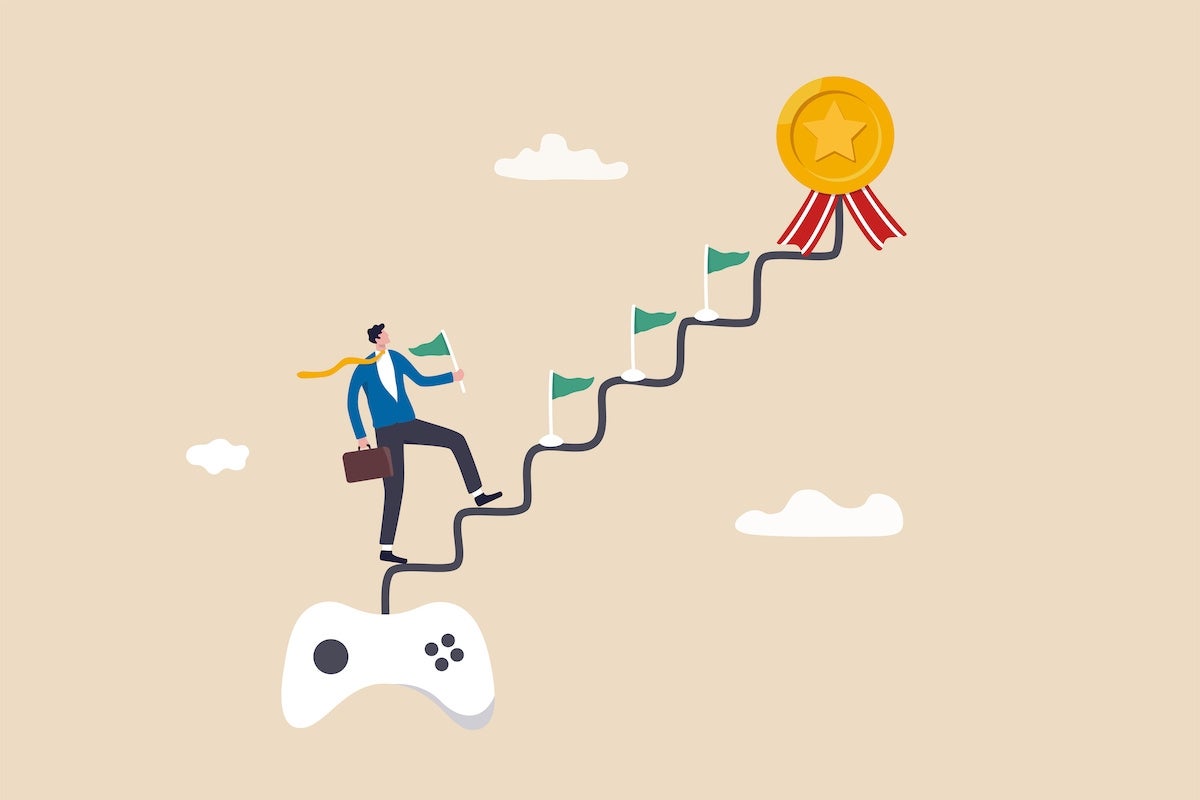
Most of us are familiar with the leaderboards, badges and special missions that video games use to keep players engaged. What many people don’t realize is that the same basic gamification strategies and tools can be adapted to boost engagement in business settings.
Gamification is becoming an increasingly popular approach to boosting both customer and employee engagement with companies. By turning desired actions into games and other interactive activities, businesses can encourage website visitors or current customers to engage with their brands’ online content. Gamification can also be a powerful employee or recruitment engagement tool.
SEE: Productivity apps and solutions to engage your employees (TechRepublic Academy)
There are a number of ways to integrate gamification elements into your business practices, especially if you use specialized gamification software, which uses game mechanics to help businesses meet specific objectives. This comprehensive guide will take you through the top options in the gamification software market that can be used to boost sales, customer engagement or even employee performance .
Jump to:
- Best gamification software
- What is gamification software?
- Uses of gamification software
- Key features of gamification software
- Choosing the best gamification software
Best gamification software
Here are the top gamification software vendors of 2022, curated based on popularity, customer reviews and features.
Engagedly
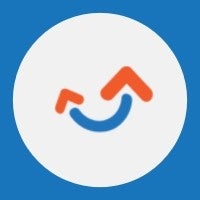
Engagedly is an HR-focused type of gamification software. If your goal is to leverage game mechanics for employee management, this might be the right software for you. It includes features centered around performance and employee engagement.
Engagedly can be used to foster more transparent communication around performance and offers many self-service features. For example, employees can view progress bars to see how they are progressing toward their set performance goals, giving them new ways to engage with their work while also enabling their managers to do ongoing performance management more easily.
Engagedly is also a great tool for keeping employees motivated. Depending on how you choose to set up the software for your team, employees can complete tasks to earn points or badges ( Figure A ).
Figure A

Features
- System and custom badge reward systems
- Real-time, one-on-one feedback and public recognition features
- Advanced analytical and reporting tools to quantify performance metrics such as engagement
- Gift card catalogs for employees to redeem earned points for rewards
Pros
- Enhanced collaboration and recognition opportunities for all users, especially among remote teams
- Intuitive scoring helps site administrators better manage each user’s gamified activities in the app.
- Engagedly enables performance teams to measure employee and user engagement across a variety of metrics.
Cons
- Unintuitive UI can make it challenging to train employees
- Lack of built-in recruiting capabilities
Influitive
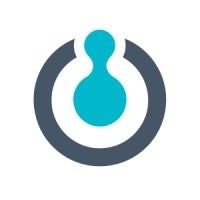
Influitive gamifies advocacy and engagement for your brand’s customers. It gamifies customer advocacy for online reviews, customer referrals, webinar and virtual event attendance, customer survey completion and more. In Influitive’s gamification software, businesses can recognize customers for every action that they take to promote or engage with the company.
A common issue with online reviews is that people are more likely to leave a review in the event of a negative experience. Gamifying the customer advocacy process is a great way to incentivize happy customers to also provide their honest positive reviews ( Figure B ).
Figure B
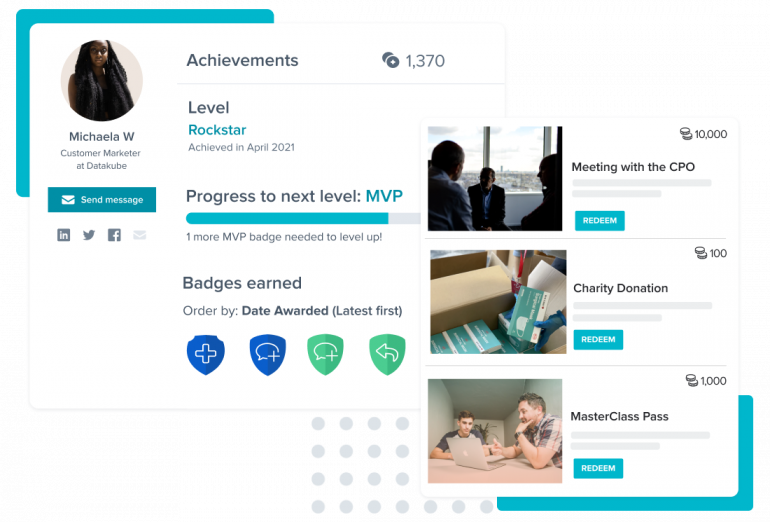
Features
- Customer journey automation
- Incentivized training and certification opportunities
- Surveys and feedback capabilities
Pros
- The Customer Experience Platform helps to build a rapport with customers to optimize user engagement and experience.
- Personalized onboarding features are provided to guide critical customer interactions.
- Detailed reporting identifies high-revenue clients and eases the process of evaluating customer advocacy programs.
Cons
- System outages and bugs sometimes dilute the user experience.
- Broader template coverage is desired by many users.
Spinify
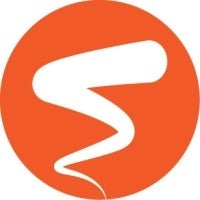
Spinify is gamification software designed to motivate your sales team. It utilizes leaderboards, competitions and employee recognition tools to motivate sales teams to hit their goals. Progress toward goals can be tracked and presented in real-time for added visibility.
Many of Spinify’s features are targeted toward larger team projects and competitions, but employers also have the option to set personalized goals and KPIs for staff members. Employees who top the leaderboard or achieve their set goals can also unlock set achievements to help employers recognize their hard work ( Figure C ).
Figure C
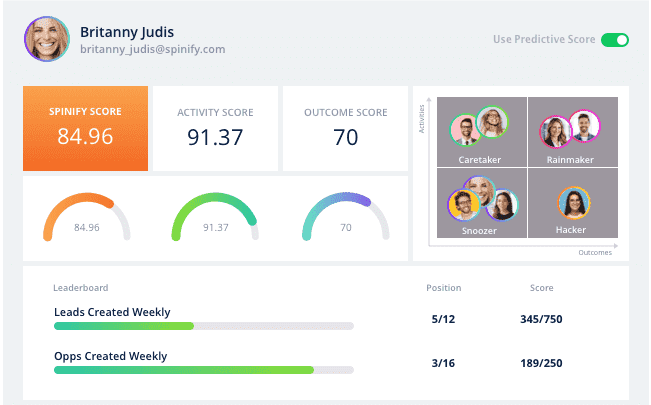
Features
- Reward system based on employee target and milestone achievements
- Automated badge rewards based on specific objectives or activities
- Level and tier creation features to compare stats and increase performance metrics across team members
Pros
- Sales gamification dashboards improve employee engagement and help keep sales teams more accountable.
- The sales-specific focus of this tool is great for motivating sales teams based on their targets and KPIs.
Cons
- There are limited options to view and compare stats between employees.
Trivie
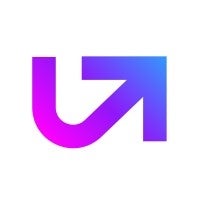
Trivie is gamified learning software that can be used to support employee training and development. The platform can measure, manage and enhance knowledge on work-related topics such as product knowledge, safety and compliance guidelines, and customer service skills. This platform can also be used to gamify employee onboarding. Employees can earn badges for completing training and move up the leaderboard for scoring highly on retention quizzes.
The platform uses AI-based learning techniques to improve knowledge retention. Its proprietary AI system creates a personalized proficiency map for each employee to forecast their current knowledge gaps and when they would need a refresher on what they have learned. The gamification platform also provides an easy-to-use reporting dashboard to help employers track learning progress and achievements ( Figure D ).
Figure D
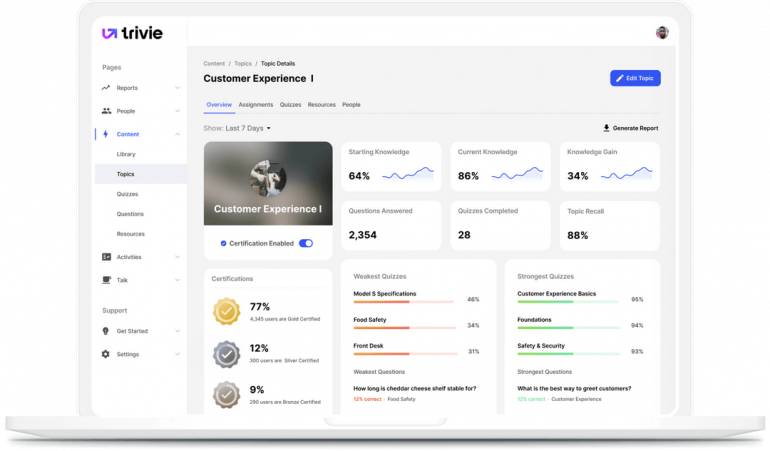
Features
- Adaptive learning methodology to personalize content and make information retention intuitive
- Power-ups, factoids, challenges, boards, comment voting and other direct engagement features
- Self-service capabilities and learning deployment across widespread workforces
Pros
- Trivie’s gamified approach to knowledge retention relies on AI algorithms and cognitive science.
- Trivie provides clear reports and access to key insights for company leadership.
Cons
- Trivie has a relatively steep learning curve for new users.
- It can prove challenging to integrate Trivie with a learning management system.
Bunchball Nitro from BI Worldwide
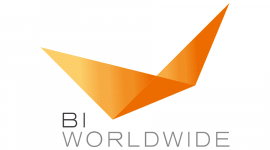
Bunchball Nitro is gamification software for enterprise businesses that primarily want to engage their staff and improve employee performance. The software can be used to incorporate gamification capabilities into a company’s sales strategy, employee management practices, partnerships and even customer outreach. This makes Bunchball Nitro one of the most robust and versatile gamification software options available.
It can be used to drive traffic to a company’s blog posts, website or social media posts through customer-facing gamification. Another popular use is to gamify employee onboarding and training. The vendor reports that using the gamification platform can reduce onboarding time from four weeks to 14 hours. Bunchball also offers mobile gamification tools to engage employees and customers from their mobile devices.
Bunchball Nitro is a great choice for enterprise companies that want a gamification solution that will fit into their existing software infrastructure ( Figure E ).
Figure E
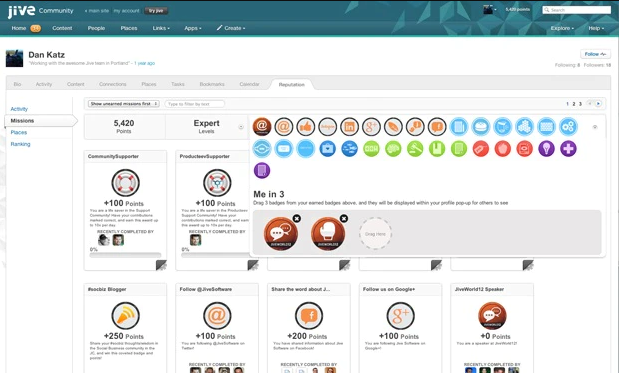
Features
- Advanced analytics and reporting
- A unified view of initiatives for tracking across different functions, such as onboarding and other programs
- Program customization capabilities
- Enterprise-grade encryption
- Manager and peer-to-peer recognition features
Pros
- This is one of the largest and most effective gamification solutions, which makes it a great fit for larger organizations.
- An intuitive user interface improves the user experience and simplifies program management.
- Bunchball Nitro can be integrated with Salesforce, Jive, SAP Jam, RemedyForce and NICE. It also has exclusive partnerships with SAP SuccessFactors Learning, SAP Jam and Jive.
Con
- The user interface could be more intuitive.
Hoopla by Raydiant

Hoopla by Raydiant is gamification software with a focus on employee motivation and communication. It offers automated, real-time motivation and recognition to keep employees going. Companies can create sales contests that are tailored toward office, in-store or remote employees, with results tracked on a leaderboard.
Hoopla helps teams recognize and celebrate wins through streaming channels with leaderboards, dashboards and progress bars. Data can be automatically gathered from Salesforce, HubSpot or other integrated tools to make goal tracking easier. Hoopla initiates celebrations as soon as an employee reaches a milestone or closes a deal.
The platform also includes communication tools so employers can send notifications to employees to share progress updates, recognize high achievers or deliver some extra motivation. It is worth noting that Hoopla has officially been integrated into the Raydiant Platform. As a result, the gamification platform can be found on the Raydiant website ( Figure F ).
Figure F
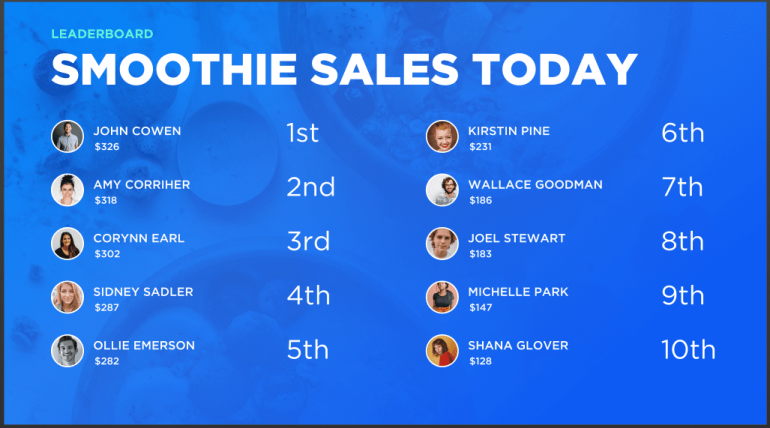
Features
- Raydiant Eat live leaderboards to promote friendly competition between franchises
- Raydiant Shop to gamify commissions, quotas and sales goals
- Raydiant Go to gamify shift-specific games and prizes
Pros
- This software offers a plug-and-play solution to enable both employees and owners to customize their experiences with numerous integrations.
- Visually engaging leaderboards help to leverage internal stats in the most impactful manner.
- Most software features are relatively easy to use for both managers and employees.
Con
- Raydiant dashboards can be complex to use.
Ambition
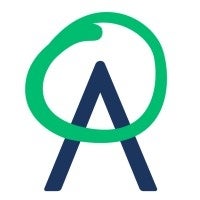
Ambition is a company that empowers performance-driven teams to achieve their goals in a work-from-anywhere environment. It combines coaching orchestration, performance intelligence and sales gamification to deliver a more effective workplace.
Its sales gamification product helps users to kindle a culture of accountability and encouragement while eradicating the manual steps that are typically involved in managing contests and tracking progress. Ambition Sales Gamification considerably decreases competition runtime, enabling teams to execute spiffs at a higher frequency while optimizing manager time ( Figure G ).
Figure G
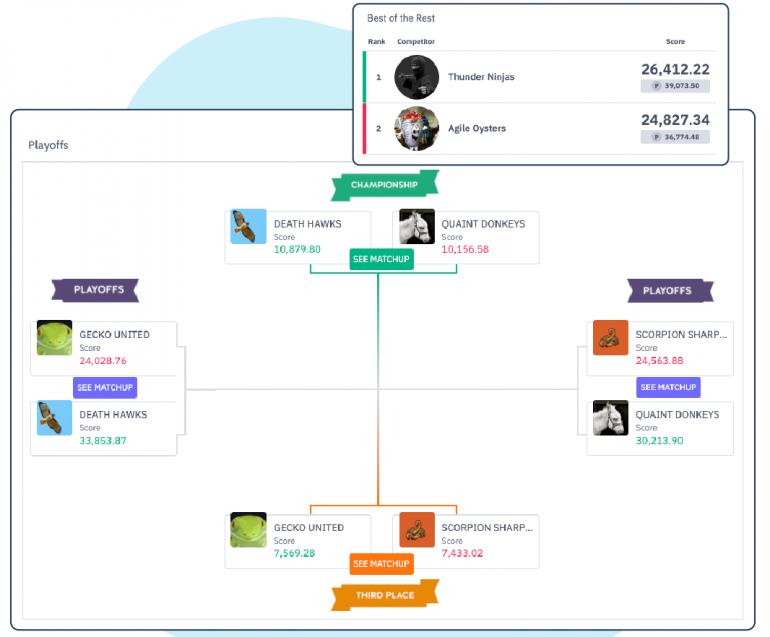
Features
- Real-time leaderboard visualizations
- Accolades to support reward programs that are calculated automatically and based on metrics such as monthly revenue goals and programs managed by team leaders
- Easy-to-create fantasy and challenge competitions
Pros
- This tool includes a variety of automations that lower the time spent on running competitions, thus optimizing time usage among teams and ensuring that competitions are more effective and efficient.
- Ambition connects with CRMs like Salesforce and offers a variety of other integrations and customizations.
- A free trial version of this tool is available to users.
Cons
- Setting up contests and metrics may present a learning curve to users.
- The user interface is not always intuitive for sales managers and other sales professionals.
- Ambition lacks a central dashboard for sales management.
LevelEleven
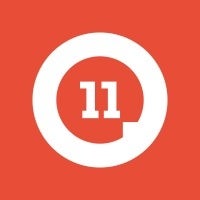
LevelEleven is sales gamification software designed to boost employee motivation and productivity through coaching, contests and more. It is targeted toward sales and customer retention teams. With LevelEleven, businesses can launch company-wide, team-wide contests or individual contests to motivate employees to meet or exceed their sales goals.
LevelEleven also connects to Salesforce to track sales data. Employers can set custom rewards to motivate employees to win contests. Top performers can also receive badges for accomplishing a goal.
The gamification platform also provides each employee with a performance scorecard. This allows the employee and their manager to track their performance metrics in real time. Managers can provide feedback through the portal based on these daily scorecards to facilitate ongoing coaching and employee development. Based on these conversations, the manager can assign action items to the employee to help reinforce the coaching sessions ( Figure H ).
Figure H
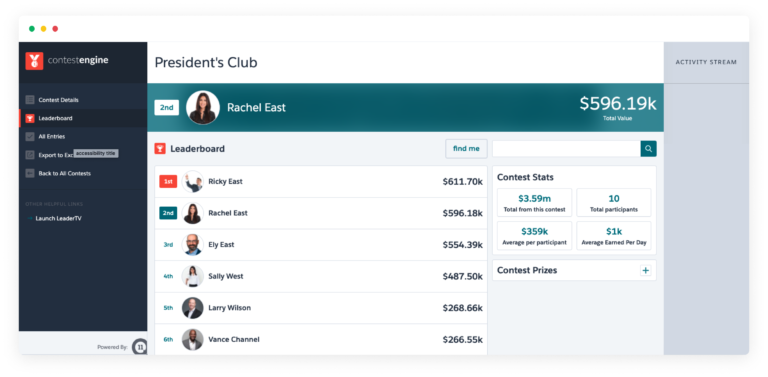
Features
- Automated productivity triggers via Salesforce, sales leaderboards and TV broadcasts
- Employee recognition features to trigger custom screen splashes
- Customization features to build custom sales contests, incentives, and more branded and intuitive user interfaces
Pros
- Employee performance scorecards allow employees and managers alike to track performance metrics in real time.
- This tool offers native integration with Salesforce.
- The Contest Engine makes it easy to create automated sales contests to motivate behavior and improve metrics in Salesforce without help from IT.
Cons
- LevelEleven can come off as complex to new users, as configuration and initial setup are not too user-friendly.
- Some teams may find the available metrics to be limited.
What is gamification software?
Gamification software utilizes game mechanics to incentivize customers or employees to perform certain actions. This can include completing challenges or tasks to earn points or badges.
SEE: How to use gamification to increase the adoption of your enterprise application (TechRepublic)
Gamification is also used to encourage customers or employees to engage with specific content. It can be used to create a sense of achievement or cultivate healthy competition among users. Gamification can increase sales, boost customer loyalty, improve employee engagement and optimize performance management.
Uses of gamification software
While many software categories are designed with specific business use cases in mind, gamification software is a border category that can be used to accomplish a number of different uses or goals. These are some of the most common use cases for gamification software:
Customer retention and growth
Gamification campaigns allow businesses to go beyond basic customer loyalty programs to continuously engage customers. Customers may be offered rewards and discounts for leaving a review, making repeat purchases, engaging with the brand on social media or engaging in other desired activities.
The key is to keep your business at the forefront of your customers’ minds so they come back to you the next time they need to make a purchase. It can also encourage word-of-mouth lead generation by incentivizing social posts or customer referrals.
Sales
Due to the nature of the job role, gamification is an especially good fit for sales teams. Gamification can tap into the competitive nature of your sales team to encourage them to compete, exceed their targets and move up the leaderboard. Gamification is great for hosting sales contests around new product launches, peak sales periods or quarterly initiatives.
SEE: CRM software: Choosing the right CRM for your business (TechRepublic)
Sales gamification encourages a collaborative spirit among salespeople that yields excellent results. It creates an engaging environment for salespeople that intuitively pushes employees to do their jobs effectively while eradicating dull work environments. Sales gamification also triggers the competitive nature of salespeople, which can raise the overall performance of sales departments.
Communication is an essential tool in sales. Sales gamification ensures that sales departments communicate better and more frequently, leading to better accountability around personal and team goals.
Learning management
Gamification can be used to improve and track the completion of customer and employee training modules. By gamifying the learning management process, employers can encourage participation in learning activities and persuade participants to do their best on any module quizzes to move up the leaderboard.
HR and employee engagement
Gamification can be used to motivate, engage and reward employees for optimized recruitment and retention efforts. Employers can use it to encourage employees to work toward goals, improve productivity or engage with company content.
SEE: Best HR analytics software (TechRepublic)
By linking rewards or public recognition to employee performance, employees are likely to feel more engaged with their jobs and valued by their employers.
Key features of gamification software
Leaderboards
Leaderboards rank participants based on points or achievements. The format is commonly seen in video games, but it can also be a great tool for motivating employees. Companies can increase competition among sales staff, recruiters or other outcome-focused teams by publishing a leaderboard with the top performers.
Leaderboards can also be published to track external parties, such as customers. With external gamification efforts, leaderboards can show who attends a virtual event hosted by your company or who participates in a customer-oriented competition.
Goal tracking
Many gamification software platforms include goal tracking. Goal tracking can be displayed with progress bars, virtual maps, or other dashboard tools and visualizations. These tools allow both the participant and the company to track performance in relation to set goals.
SEE: Best data visualization tools and software (TechRepublic)
Sometimes these are general goals set for all employees or customers. However, they are often more personalized and customizable when they are intended for internal or employee use. Goal-tracking features often aid in employee performance management.
Badges
Badges can be awarded within many gamification platforms. These badges recognize employees or customers for their achievements. Reasons to earn a badge can range from meeting a specific sales goal to completing a customer website engagement challenge. These badges can be displayed publicly in a social newsfeed or on a user’s profile for public recognition.
Rewards
In most gamification systems, participants can earn points by completing activities. Sometimes these points are simply used to advance to a higher level, earn a badge or move up the leaderboard. However, many gamification software platforms offer users a way to spend their points for gift cards or other company prizes. Rewards features incentivize employees to earn points and actively participate in whatever performance metrics are gamified.
Social features
Many gamification software tools also incorporate social elements. This can come in the form of a social news feed that allows other users to view points earned or goals completed by other participants. They may also include user comments or employee recognition. Some more advanced gamification solutions also engage customers in forums or other social activities to create an ongoing conversation around the brand.
Reporting
Like most enterprise software, gamification software typically includes reporting and analytics tools. These features allow businesses to track the impact of gamified elements by showcasing data on staff performance, completion rates and scores for learning modules. Reporting can also illustrate the ROI of gamified customer loyalty or advocacy programs.
Choosing the best gamification software
When choosing the best gamification software option for your business, it is important to consider how you intend to use the software. Gamification can be used by several different departments to accomplish different goals.
SEE: The Business Leadership & Management Training Bundle (TechRepublic Academy)
Customer-oriented gamification solutions are a great way to turn your loyal customers into brand advocates. Businesses can also take a different approach and use gamification to drive sales and customer retention by creating competitions or challenges for sales and customer success team members . Most gamification tools are tailored toward a specific business use case, so consider what you hope to get out of gamification before choosing a gamification software solution.
Read next: The best applicant tracking systems (TechRepublic)
